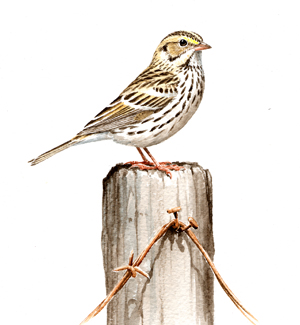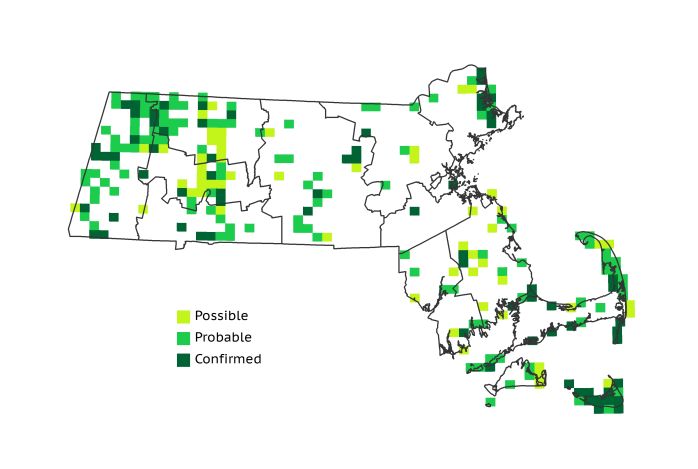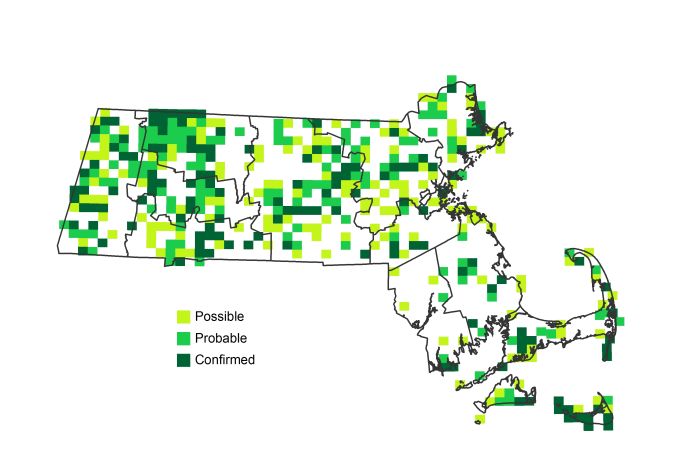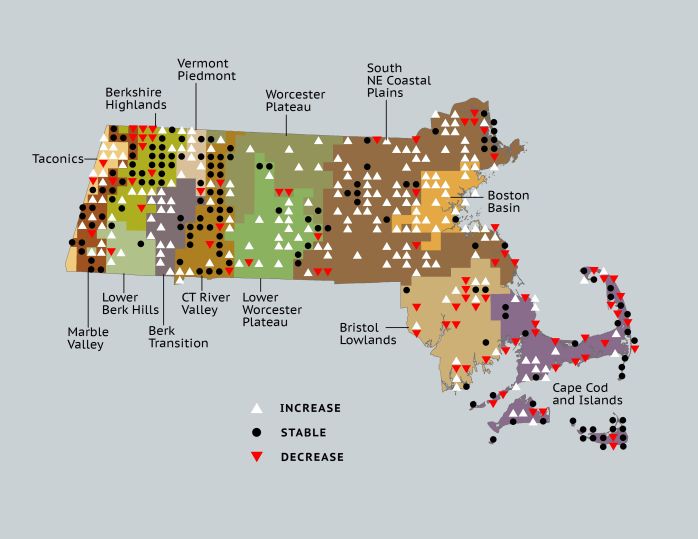Find a Bird
Savannah Sparrow
Passerculus sandwichensis

Fairly widespread and likely increasing
Action/monitoring needed
“I once had a sparrow alight upon my shoulder for a moment while I was hoeing in a village garden, and I felt that I was more distinguished by that circumstance than I should have been by any epaulet I could have worn.” – Henry David Thoreau, Walden
Despite its fondness for scrubby fields and grasslands, this species is named not for its habitat but for the city of Savannah, Georgia. It was there that the first specimen was collected for science, so Alexander Wilson assigned the city’s name to the bird. Interestingly, the Savannah Sparrow does not breed in the warm and welcoming southern city of Savannah, but it does breed in Massachusetts. Unlike many of its fellow grassland sparrows, the Savannah Sparrow seems to live throughout the Commonwealth, possibly due to the wide variety of open and semi-open habitats that it is willing to use for nesting. The species’ breeding range is impressively large, sweeping across the US and Canada, to the far northern reaches of Alaska. It clearly can exploit a wide range of resources across that range, and that adaptability may be serving the bird well in Massachusetts.
Historic Status
Even during the heyday of agriculture in Massachusetts, Savannah Sparrows were considered rare in comparison to Song Sparrows, and they were described as “most common near the sea,” (Peabody 1839). Farmlands, however, certainly offered these buzzy little songsters homes all across Massachusetts. Near the beginning of the twentieth century, Forbush listed it as breeding “along river valleys, in upland meadows, fertile fields and pastures,” (Forbush 1907), and suggested that it was common in favorable habitat in the Berkshires, the Connecticut River Valley, and along the coastline. Through time, as grasslands vanished, it seemed likely that the species might decline in the state. Curiously, no such population disintegration was reported in the state’s rich ornithological literature during the first two-thirds of the twentieth century.
Atlas 1 Distribution
As Massachusetts was leaving its agricultural history by the wayside in Atlas 1, Savannah Sparrows were still breeding across the state in scattered patches wherever there was favorable habitat, occupying about 25% of the state. The patterns of occupancy were patchy; the high meadows of the Berkshire Highlands and the rolling pastures of the Marble Valleys both exceed 50% block occupancy. In the Connecticut River Valley, Savannah Sparrows were present in 61% of the blocks, but their breeding activity was much more scattered in the Worcester and Lower Worcester Plateau regions. In the Coastal Plains, most Savannah Sparrow records were concentrated near eastern Essex County. The sandy, scrubby habitats of the Cape and Islands were particularly hospitable to Savannah Sparrows in Atlas 1, especially on the Outer Cape and in the sandplain grasslands of Nantucket.
Atlas 2 Distribution and Change
Given the disappearance of grassland and field habitats in the state, one would predict that Savannah Sparrows are declining, but they appear to be doing just the opposite. Although in some regions (e.g., Cape Cod and the Islands, and Bristol/Narragansett Lowlands), they have disappeared from more blocks than they have colonized, in most other regions they have appeared in more places than they have abandoned, and have upped their statewide block occupancy to 41%. They showed notable growth in the Taconics, Vermont Piedmont, Berkshire Transition, and Boston Basin ecoregions, and also grew in all other regions, except those in the southeast. In an age when most grassland nesters are obviously declining in Massachusetts, the plucky little Savannah Sparrow is showing a notably increasing footprint.
Atlas 1 Map

Atlas 2 Map

Atlas Change Map

Ecoregion Data
Atlas 1 | Atlas 2 | Change | ||||||
Ecoregion | # Blocks | % Blocks | % of Range | # Blocks | % Blocks | % of Range | Change in # Blocks | Change in % Blocks |
Taconic Mountains | 3 | 18.8 | 1.3 | 10 | 40.0 | 2.3 | 6 | 40.0 |
Marble Valleys/Housatonic Valley | 24 | 61.5 | 10.0 | 29 | 74.4 | 6.8 | 5 | 12.8 |
Berkshire Highlands | 29 | 52.7 | 12.1 | 32 | 58.2 | 7.5 | 2 | 3.8 |
Lower Berkshire Hills | 3 | 10.7 | 1.3 | 6 | 19.4 | 1.4 | 3 | 11.1 |
Vermont Piedmont | 7 | 41.2 | 2.9 | 14 | 82.4 | 3.3 | 5 | 41.7 |
Berkshire Transition | 3 | 7.9 | 1.3 | 18 | 45.0 | 4.2 | 14 | 45.2 |
Connecticut River Valley | 34 | 60.7 | 14.2 | 45 | 69.2 | 10.5 | 7 | 14.6 |
Worcester Plateau | 7 | 9.0 | 2.9 | 25 | 28.4 | 5.9 | 6 | 12.5 |
Lower Worcester Plateau | 9 | 12.2 | 3.8 | 30 | 37.5 | 7.0 | 14 | 25.9 |
S. New England Coastal Plains and Hills | 38 | 14.1 | 15.8 | 114 | 40.3 | 26.7 | 50 | 22.1 |
Boston Basin | 1 | 1.8 | 0.4 | 25 | 44.6 | 5.9 | 23 | 41.8 |
Bristol and Narragansett Lowlands | 20 | 18.9 | 8.3 | 17 | 14.9 | 4.0 | -4 | -4.0 |
Cape Cod and Islands | 62 | 45.6 | 25.8 | 62 | 43.1 | 14.5 | -6 | -5.0 |
Statewide Total | 240 | 24.8 | 100.0 | 427 | 41.2 | 100.0 | 125 | 15.1 |
Notes
News this good, especially in the face of reasonable expectations that would predict an opposite trend, needs to be taken with a grain of salt.Despite this species’ apparent growth in distribution, the Breeding Bird Survey (BBS) shows significant declines in abundance for Massachusetts, the New England/Mid-Atlantic Region, and the Eastern US overall. They fall into our “whispering bird” category – those species with a demonstrated stable or increasing breeding footprint from Atlas 2 data, but also a demonstrated decline in abundance from the BBS. This drives our final assessment that this is a species with a need for further monitoring and conservation action.



